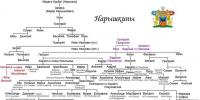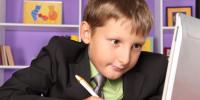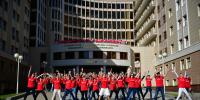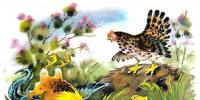Talented and gifted methodological development on the topic. Coaching "Talented and Gifted" Independent and test work
Goal: To develop teachers’ knowledge about the concept of “giftedness.”
Expand teachers’ ideas about ways to support talented children.
Learning objectives: 1. To introduce the qualities of gifted children in various fields through a key presentation.
2. Consider different types of intelligences using the resource “Correlating types of intelligence with types of tasks”
3.Promote the use of techniques to support gifted children, based on the practice of teachers.
Learning outcome: The teacher must:
Know the qualities of gifted children.
- establish a position of respect for the student’s individuality;
- select learning strategies that promote the development of independent thinking, initiative and creativity.
Basic (key) ideas: Concepts of “giftedness”, signs of a “gifted child”.
Types of intelligences.
Training-warm-up (+ video warm-up
“Erudition Test”) Coach: I offer you, colleagues, an interesting training: “Convert one subject into another.” Goal: developing the ability to connect what is observed with previously developed theoretical concepts).
Try transforming one item into another. This is done in stages; at each stage, only one attribute of the item can be changed. For example, how to turn a pillar into a hole. First, the pole can be made hollow inside, then sawed into shorter parts, then one of the parts can be dug into the ground.
DOOR-BICYCLE, FLOWER-FLOWER-HEATING RATTER, BOTTLE-HOUSE, TREE-BOOT.
- What do you think the warm-up gave you?
5 minutes
Formation of groups: Coach: Groups today are formed using the method of impromptu forfeits: one of the teachers, with his eyes closed, calls the number of the group where the participant to whom the coach is currently pointing will go. 2 minutes
Types of tasks:
Approaches used for
completing this task Actions of the coach and actions of the coaching participants Time
Introductory task. Statement of the problem: watching the video
“A 3.5 year old girl plays the synthesizer”
Video discussion.
Our first task:
Groups 1-2 are asked to write down the qualities of a gifted child in order of importance. Then explain your choice.
(You can make a poster)
Groups 3-4: create a “Giftedness Map”
Fill out the table, distributing the main qualities of gifted children. Column 1 - qualities in the field of cognitive development, 2 - in the psychosocial sphere.
(Qualities are given all together, you can cut and stick)
Sphere of cognitive development Psychosocial sphere
Group 5: experts complement.
- What impression did you have of what you saw?
- How would you define this category of children?
- Try to understand, based on our training, what will be the topic of our lesson?
-Is this topic modern?
How did you determine the identity of this or that quality?
Correct answer:
Logic tasks: “Test yourself”
Final reflection:
Reading the parable
Each group is offered different tasks to
logic, imagination, knowledge in different areas. It is necessary to solve problems by imagining ourselves as children.
“Plus – minus – interesting.”
Parable about a little boy.
One day a little boy came to a big school. And at the very first lesson the teacher said: “Children, now we will draw flowers.” The little boy loved to draw flowers and immediately set to work, but the teacher stopped him. “Wait,” she said. “I haven’t yet explained what kind of flower we will draw and how it should be done.” And she added: “We will draw... a red flower with a green stem.”
And at the next lesson the teacher said: “Now, children, we will sculpt flowers.” The little boy immediately got down to business, but the teacher immediately stopped him: “Wait! I haven’t yet said what kind of flower we will sculpt and how it should be done. Now, children, we will sculpt... a red flower with a green stem...”
And then it happened that the little boy moved to another school. And another teacher suggested during the lesson: “Children, let’s draw flowers.” And then she went up to the little boy and asked: “Why don’t you draw anything?” And he replied: “But you haven’t yet announced what kind of flower should be drawn and how it should be done.” And the teacher said: “Draw the flower you like.”
And then the little boy drew... a red flower with a green stem.
When it comes to creativity, how do we find the limits of teacher intervention? We strive to develop creative thinking in our students, but are we able to sense the moment when it is better not to interfere, to step aside and observe the birth of individuality?
Video. Coach:
- Will children be interested in such tasks?
- When and how can they be used?
Coach: listen to the parable and tell me why it was heard at the end of our lesson?
5 minutes.
Resources http://cptd.ippk.arkh-edu.ru
Power point presentation
Excerpt from an article by N. Rogers.
Video clip “The world around us”
Paper, markers.
You can provide websites on the topic of coaching for later reference:
http://www.effecton.ru/762.html
http://intellektsystem.ru/articles_1_71.html
http://adalin.mospsy.ru/l_01_00/l_01_12a.shtml
http://www.msph.ru/jornal/arhiv/38/38.pdf
Almaty city Turksib district KSU secondary school No. 49
Coaching for teachers
Mathematics teacher M.V. Stark/first advanced level/
| Lesson Coaching for teachers Lesson date 08/24/15. |
|||
| Lesson topic: | Talented and gifted children. Study the module to open up new opportunities for working with T&E students. |
||
| Promoting the development of students' T&E skills |
|||
| Updating teachers’ ideas about working with gifted and talented children; To familiarize students with the types of giftedness; Consider the psychological foundations of teacher interaction with talented and gifted students; |
|||
| Expected learning outcome: | The teacher must: Be able to identify gifted and talented students in your class by observing student behavior during their learning process; Understand the essence of the conditions that need to be created for talented and gifted students during training; Be able to create educational tasks using Bloom's taxonomy (analysis, synthesis, evaluation for the development of high-level thinking. |
||
| Methodical manual for teachers-2012, handouts, presentation, video clips. |
|||
| Progress of the lesson |
|||
| Warm-up: | Exercise “getting to know each other, wishing each other” - 3 minutes |
||
| into groups: | Forming groups using stickers that depict leaves, butterflies, apples (Who likes what?) - 2 minutes Repetition of the rules for working in a group (the rules are posted in a visible place). |
||
| Progress of the lesson: |
|||
| Immersion in the topic | Video - video "Gifted Children". Exercise 1 Coaching participants receive handouts to study: First group studies his text. The participants make up the cluster “Image of a talented and gifted child. Characteristics of learning, thinking, motivation to learn.” Second group studies his text. The participants make up the cluster “Image of a talented and gifted child. Characteristics of public leadership and independence.” Third group studies his text. The participants make up the cluster “Image of a talented and gifted child. Types of giftedness." When speaking when defending a cluster, students present their criteria for understanding. Based on the results, the answers to the following questions are summarized: Which children can be called gifted? Which students at our school would you classify as talented? | ||
| Group | Task 2. View the presentation www.prezentacii.com “Gifted child. Who is he?" After viewing the slides and defining a gifted child, formulate a definition for each type of giftedness. 1st group – define artistic and musical talent; 2nd group – define social and psychomotor giftedness; Group 3 – define intellectual and academic giftedness. Create an image of a student showing abilities in a certain area during the lesson (using the example of a student from a real class at our school) | ||
| Individual work | Task 3 “Determination of the psychological foundations of a teacher’s interaction with capable and gifted students” Read the description of the teaching situation and evaluate the organization of the learning process reflected in the situation. Situation “Red horses on blue grass”/Appendix 1. Discussion of the situation: 1. Comment on the teacher’s activities in accordance with the topic of the lesson. 2. Create an image of a student. 3. Offer your option for getting out of the current situation. The results of the work are heard and the results are summed up. | ||
| Homework Create tasks that exceed the basic level of thinking skills (according to Bloom's taxonomy) and include activities that require high-level thinking skills - analysis, synthesis | |||
| Reflection: | Video – clip “The most gifted people on earth” / very positive/ Reflection sheet/Appendix 4/: Did the work benefit you personally or others? Fill out the leaves with stickers “+”, “-” | ||
| Presentation, markers, posters, stickers Printed handout from the Teacher's Guide, online. |
|||
Annex 1
Read the description of the teaching situation and evaluate the organization of the learning process reflected in the situation.
Situation "Red horses on blue grass."
The grandson came home from school sad and thoughtful. “What happened?” I ask. He shrugged his shoulders. “Did you really get a bad grade?” He sighs, without looking at me, and says: “Grandfather, and grandfather.” What kind of horses are there? Well, what color? - What do horses have to do with it? - Well, what kind? - Bay, that means color... - What is color? - This is the color of the coat. The bay horse is reddish-brown. There is also a dun horse - light yellow in color. - Tell me, grandfather, are there red horses? The grass is blue. I saw it myself. In the village. White smoke was still floating above her. - Do you want to say - fog? - Let it be fog. You see, under such smoke the grass turns blue. So I painted red, red horses and blue, blue grass on which they grazed. And she...she... -Who is “she”? -Teacher. He says it doesn't happen like that. He says horses are red, gray, black. And the grass is green. But I saw, you know, I saw... I didn’t know how to react, because the teacher said, and her word should be authoritative. - Okay, okay... We’ll figure it out. And I couldn’t get it out of my head: “Red horses... red horses.” Like Petrov-Vodkin’s “Bathing of the Red Horse.” Of course, the second-grader grandson doesn’t know this artist yet. But he saw his own and drew it as best he could, as he felt. And it’s good that the world is so colorful for him that the boy has his own perception of life. After all, this, in my opinion, is clear to everyone. But I still decided to go to school. No, not because of the two. Someday you should meet your grandson’s teacher and talk to her. In short, I went to school. A big change had just begun. I looked into the class. There were no students. Two young women, undoubtedly teachers, were trying on a sweater. They didn't pay attention to me. I coughed politely. No reaction. He went out and closed the door. Walked around a bit. He looked into the classroom again. “Who do you want, man?” – one of the women asked with annoyance and challenge. I introduced myself, said that I needed a teacher for Andreika’s grandson. “It’s me,” the teacher said without blinking and began frequently: “The boy is okay, capable, doing well.” True, there are a lot of flies in my head. -What? What flies? – I didn’t understand. “Ordinary ones,” the teacher said, taking off the sweater. “For example, I drew red horses for some reason.” Are there such things? Or blue grass!.. Some kind of nonsense. After all, the grass is always green. I gave him a deuce. -But, excuse me... Remember, “Bathing the Red Horse” by Petrov-Vodkin... -I don’t remember anything. Probably some kind of avant-garde artist... There are so many of them now! - But this is a great master. Besides, he died a long time ago. -Moreover, copying is not allowed. You need it yourself, as it is in life. The conversation became meaningless. The second teacher left long ago. Students began to look into the classroom. The bell rang. -Okay. So, the sun is yellow, the snow is white, the sky is blue... - How could it be otherwise? – The teacher looked at me with rounded eyes and bewilderment. - How?.. I didn’t answer. Said goodbye. I felt sorry for her. But I feel more sorry for the second-graders she taught.
Appendix 2
Used Books:
Program of advanced training courses for teaching staff of the Republic of Kazakhstan Nazarbayev Intellectual Schools JSC, 2012
2. Guide for teachers, pp. 197-205, Nazarbayev Intellectual Schools JSC, 2012
3. URL: www.prezentacii.com “Gifted child. Who is he?"
Appendix 3
Videos: “Gifted Children”, “The Most Gifted People on Earth”.
Appendix 4
Reflection sheet
1. Was the work beneficial to you personally or others? Which?
________________________________________________________
________________________________________________________
________________________________________________________
________________________________________________________
2. What was the main discovery for you?
________________________________________________________
________________________________________________________
________________________________________________________
________________________________________________________
________________________________________________________
________________________________________________________
________________________________________________________
3. What did you like most?
________________________________________________________
________________________________________________________
________________________________________________________
________________________________________________________
________________________________________________________
4. What should a coach consider for the future?
________________________________________________________
________________________________________________________
________________________________________________________
5. What topic do you propose to conduct the next coaching on?
_________________________________________________________
Title of the lesson: Date: General goals: Learning outcomes: Key ideas: Assignments: Coaching with a focus group of colleagues “Creative and proactive” “What should be the lesson for a gifted child in a public school?” Participants will be able to discuss the problems of organizing education for gifted children in the classroom; will create a project of an educational lesson environment for OA; will develop a mini-lesson for a gifted child. Participants know: the concept of giftedness; how the capabilities of gifted children manifest themselves in joint activities; Strategies for teaching gifted children. Able to: work in a group; use learning strategies for personal benefit. Create: a mini-lesson project for a gifted child. The module “Education of Talented and Gifted Children” is included in the Program of Level Courses. There are challenges regarding the education of gifted and talented children; It is important to carefully think through, discuss and plan lessons to include these children. 1. Motivation “Reincarnation”. Now you have to play the role of gifted children. We put on the “gifted child’s jersey.” 2. Assignment: you are a gifted child, now you must write down the problems that you encounter in a public school. 3. Watch the video “The World Through the Eyes of Gifted Children.” As you can see, there are quite a lot of problems. We need to learn to deal with them. 4. Assignment: Let's return to our role, the role of the teacher. What is your goal today? 5. Discussion of the lesson plan Participants come up with a motto with which a gifted student can come to the lesson. They announce their mottos. Each participant must highlight the main problems of a gifted student. They compare them with “their” problems. They turn over the “shirt - emblem”, write down their goal for the lesson (what they want from the session). Participants think about the answer for 30 seconds. Discussion, discussion.
Who has the most learning problems? Why? Why can gifted students be said to be at social “risk” in the mainstream learning environment? What emotional characteristics can be given to gifted children? How do the emotional characteristics of gifted students influence educational activities? Think of one of your students for whom these characteristics are a barrier or a helper. 6. Questionnaire “Qualities of students.” Agree, a teacher does not feel very comfortable during a lesson in a class where there are gifted children. Why is this happening? Musical and dance break 7. Division into groups “Identical pictures”. 8. Designing an educational lesson environment that promotes the learning of gifted children. 9. Comparison of work results with resource No. 3. Evaluating your own work. 10. Work in pairs based on subject interests. Resources No. 4, 5. Designing a mini-lesson. Task: to create conditions for teaching gifted children (specific school students) Reflection “Beautiful Tulip” 11. Presentation of mini-lessons. Use resource No. 1 Name the students who learn from the majority, in order to then design a mini-lesson in a subject-specific manner. Participants mark + or – qualities of children that they like or dislike. Discussion. Participants receive a picture and form groups. Fill in the blanks in the table. Resource No. 2 Participants study resources No. 4, 5. Create a mini-lesson project using the proposed methods or their own developments. Summarizing. Participants
And now I suggest you attach butterflies to a flower that symbolizes a gifted child, on which you write down what you can use from the lesson materials in your work. Place stickers in the form of butterflies on a flower located on the board. You can write down a wish or question on a sticky note.
Know the concepts of giftedness, talent, genius. Be able to apply different approaches to teaching gifted children at school.
Expected Result:
Understanding the essence of the conditions that need to be created for talented and gifted students. Understand what changes need to be made to assignments that include intellectually stimulating tasks for talented and gifted students. Ability to plan challenging group assignments for talented and gifted students in which students demonstrate their potential. Identify various skills that can be used by teachers when working with children of different abilities when completing joint tasks.
Target audience: teachers
Form of implementation: brainstorming, group work, project defense, reflection.
Resources: markers, presentation, stickers, posters, videos.
Stages of work | Participants' activities | |||
Preparatory and organizational. The purpose of the stage: to organize a positive attitude of participants for effective work in the lesson. creating a positive attitude among participants for effective work in class; ensure the rapid inclusion of participants in the work. conversation; verbal and non-verbal means of communication that help create a positive attitude (smile, friendly tone, look). Division into groups. | Good afternoon, dear colleagues. I am very glad to see you at the coaching session. Formulating the topic of the lesson Today we will talk about teaching talented and gifted children Let's get started. The coach circulates pieces of paper with the letters T S O G written on them. The coach asks the question: “What do you mean by the letter...”. Gives out signs with the names of groups: talented, capable, gifted, brilliant. | Watch a video Participants engage in dialogue and take an active position. Set up to be organized and efficient work in class. Having united in groups, they sit down. | Video 4 year old prodigy Cards with letters |
|
Main part. The purpose of the stage: training gifted and talented children. Objectives: learn to apply new approaches in teaching gifted students Methods and forms: brainstorming, group, presentation, poster defense | Coach: Dear colleagues, we all try to pay special attention to gifted students, but often the learning results do not suit either us or the students. Let's think about what approaches will allow us to achieve high results in teaching gifted students? From your words, we can formulate a conclusion in the words of Arthur Schopenhauer: “Every child is partly a genius, and every genius is partly a child.” Theoretical material Explanation. Group 1 - Create a model of a talented, gifted student Group 2 - Definition of the concepts of giftedness, talent, genius and the relationship between them Group 3 - Abilities and inclinations, the relationship between them. Group 4 - Basic approaches to teaching gifted and talented children at school. Observing the work of groups. I watch and listen to the defense of projects | Brainstorm. Unfinished sentence Talent is... The group speaker answers the question. View the presentation Watch a video Group work Discussion Groups present their projects. |
| Suggestion sheets Video “Gifted Children” Posters, markers |
The final stage. Methods and forms: individual work | Coach: Dear colleagues! Now we have decided on the main approaches to developing students’ giftedness. Dear colleagues, now let’s all analyze our work together. I ask you to leave your reflection on stickers. I wish you fruitful work and see you again! | reflection Watch a video |
|
Video "Talented Children" |
List of Internet resources
http://www. travelers. ru/youtube_video-4-letnijj-vunderkind
http://www. /watch? v=dojzmAMc5SM
http://go. mail. ru/search_video
Annex 1
Brainstorm.
Unfinished sentence
Talent is...
For capable and talented students in their studies...
It's easy to be gifted because...
Students become geniuses if...
Appendix 2
Presentation “Working with gifted children.”
Video “Gifted Children”
Video “4 year old child prodigy”
Video “Talented Children”



